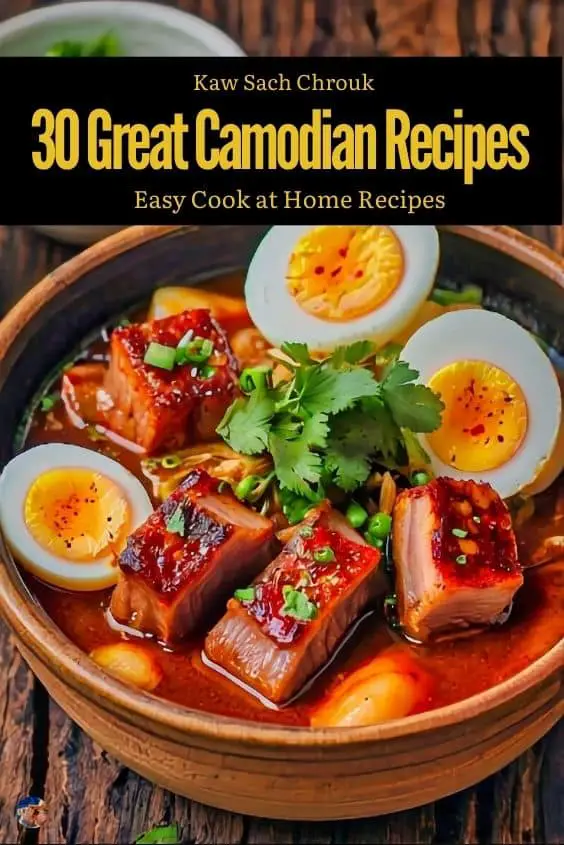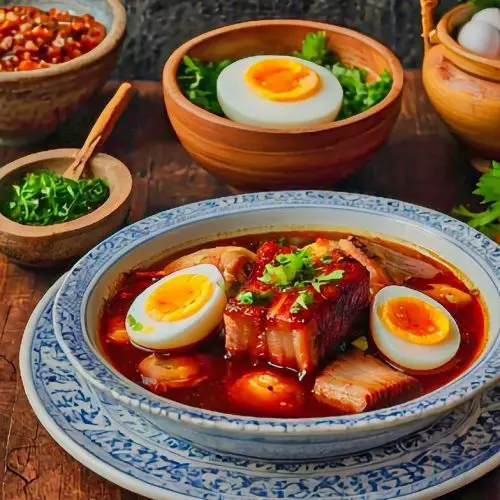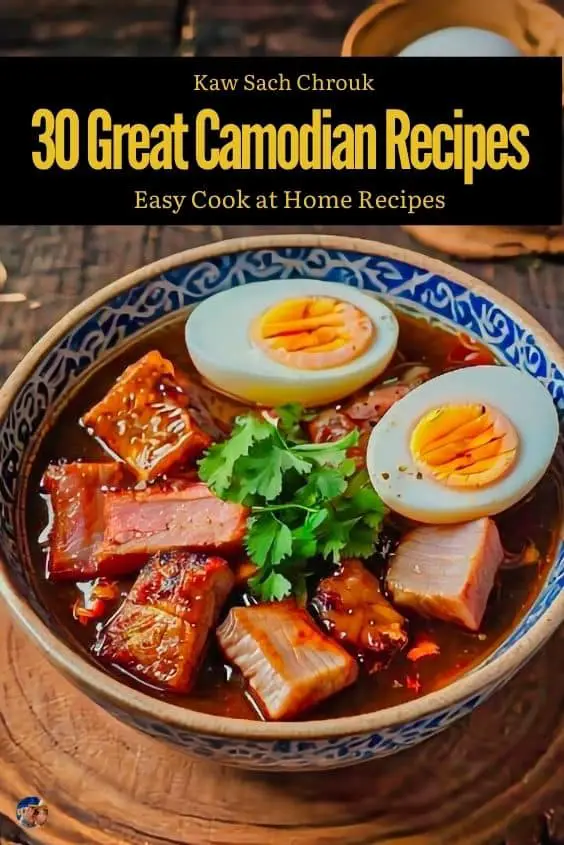Cambodian Kaw Sach Chrouk is a pork dish that immediately caught our attention with its appearance. The slow-cooked pork has a deep caramel colour, covered in a thick, shiny sauce that coats the meat perfectly. There’s nothing overly decorative about it—just a simple, straightforward look that reflects its flavour. The way the pork falls apart as you cut into it shows how tender it is, and the sauce gives the meat a rich and appealing finish.
As we sat down to enjoy the Cambodian Kaw Sach Chrouk, the texture stood out the most. The pork was incredibly tender, almost melting as we ate, while the thick sauce clung to each bite, making sure nothing was dry. The dish wasn’t served with any extra garnish or elaborate presentation. Its simplicity was part of its appeal, allowing the focus to stay on the pork itself and its natural, slow-cooked richness.
During our trip, after trying the dish, we were able to get the recipe for Cambodian Kaw Sach Chrouk. It wasn’t difficult to understand how such a simple-looking dish could be so rich in flavour. The balance between the tender meat and the glossy sauce made it clear why this is such a popular dish. We knew we had to try making it ourselves once we got back home.
The experience of eating Cambodian Kaw Sach Chrouk was more about the meal itself than anything else. There were no complicated ingredients or elaborate sides, just the pork and its sauce. The way the dish was presented made it clear that it didn’t need anything extra to impress. It was all about the taste and texture, which made every bite enjoyable.
We left with a sense of satisfaction, knowing we had tried something truly unique to the area. Cambodian Kaw Sach Chrouk wasn’t flashy or over the top, but it made an impact with its simplicity. It’s one of those dishes where the flavour and texture speak for themselves without needing anything fancy.

Ingredients For the Kaw Sach Chrouk Recipe
Pork Shoulder
Sugar
Soy Sauce
Fish Sauce
Vegetable Oil
Garlic
Shallots
Red Chilies
Lemongrass
Cilantro
Green onions
Steamed rice
Cooking Instructionsfor the Kaw Sach Chrouk Recipe
- For approximately 5 minutes, over medium heat, melt the sugar in a big pot. Once melted, it will turn a golden brown color.
- Mix in the fish sauce and soy sauce with the caramelized sugar.
- Place the saucepan over medium heat and add the vegetable oil. After about two minutes of cooking, add the shallots, garlic, and chilies to the pan.
- Cook the pork for approximately 5 minutes, or until it is browned on all sides.
- Stir the pork in the soy sauce and caramelized sugar mixture, then pour it over.
- Mix the cilantro and lemongrass in the pan.
- Simmer, covered, for approximately 1 hour, or until pork is cooked through and sauce has thickened.
- Top the steamed rice with the Kaw Sach Chrouk and top with chopped green onions.
10 Reasons Why to Eat Cambodian Food
1. Balanced Flavors – Cambodian cuisine is known for its balanced mix of sweet, sour, salty, and spicy flavors. Unlike some other cuisines that might lean heavily on one flavor profile, Cambodian food expertly combines these elements in a single dish. This balance creates a satisfying and well-rounded taste experience, appealing to a broad range of palates.
2. Fresh Ingredients – Cambodian dishes emphasize the use of fresh, locally sourced ingredients. From herbs like lemongrass and kaffir lime to seasonal vegetables, the freshness of ingredients plays a key role in enhancing the flavor. This focus on fresh produce not only adds to the taste but also makes the food healthier and more nutritious.
3. Healthy Options – Many Cambodian meals are light, with a focus on vegetables, fish, and rice, making them a great option for health-conscious eaters. Soups like Samlor Machu (a sweet and sour soup) are packed with fresh vegetables and lean protein, making it both filling and nutritious. Grilled dishes also provide a lower-calorie alternative without compromising on taste.
4. Cultural Diversity – Cambodian food has been influenced by Chinese, Thai, Vietnamese, and even French culinary traditions. This unique blend of cultures has resulted in a rich culinary landscape, offering dishes with diverse textures, flavors, and preparation methods. Whether you’re craving noodles, curries, or grilled meats, Cambodian cuisine has something to offer.
5. Fish Amok – This is one of Cambodia’s most famous dishes, a delicate fish curry steamed in banana leaves. Its rich, creamy coconut base is flavoured with fresh herbs and a special spice mix called kroeung. Fish Amok is a symbol of Cambodia’s culinary identity, and trying it gives you a real taste of the country’s heritage.
6. Khmer Barbecue – Cambodian barbecue is not just about the food, it’s an interactive dining experience. Grilled meats are served with a variety of dipping sauces, vegetables, and rice, allowing diners to customize each bite. It’s a fantastic way to enjoy a social meal with friends and family while exploring different combinations of flavors.
7. Nom Banh Chok – This traditional breakfast dish, also known as Khmer noodles, is a light yet flavorful way to start the day. The dish features fresh rice noodles topped with a fragrant fish-based broth, herbs, and green vegetables. It’s a staple in Cambodian households, offering a refreshing and healthy breakfast option that’s perfect for a warm day.
8. Affordable – One of the best things about Cambodian food is that it’s incredibly affordable. Whether you’re dining at a street stall or a local restaurant, you can enjoy a full, delicious meal without spending much. This makes Cambodian cuisine accessible to both locals and travelers on a budget.
9. Street Food – Cambodia’s street food scene is vibrant and diverse, offering everything from grilled meats to exotic snacks like fried insects. Street vendors provide a quick, affordable, and exciting way to sample authentic Cambodian flavors. It’s an adventurous way to explore local cuisine while immersing yourself in the culture.
10. Community Experience – Cambodian meals are often shared, with several dishes placed in the middle of the table for everyone to enjoy. This tradition fosters a sense of togetherness and conversation during mealtimes. It’s not just about the food; it’s about enjoying the company of others and creating lasting memories around the table.
How Do I Properly Use Prahok (Cambodian Fermented Fish Paste) in Home-Cooked Meals?
Prahok, a staple in Cambodian cooking, is a strong-smelling, fermented fish paste that adds a deep umami flavor to various dishes. Though its pungency can be intense, when used correctly, it brings a unique complexity to your meals.
To start, prahok is often used in small quantities due to its strong flavor. It can be added directly to dishes like stir-fries, soups, and stews to enhance the overall taste. For example, in traditional dishes such as Samlor Machu Kroeung (a Cambodian sour soup), prahok is blended into the broth to provide a savory balance to the tangy tamarind and lemongrass flavors.
For beginners, incorporating prahok into a sauce or marinade can be a more approachable method. Combine a small amount of prahok with ingredients like lime juice, garlic, and chili to make a dipping sauce for grilled meats or vegetables. This allows you to control its intensity while enjoying its distinctive taste.
If you’re cooking a stir-fry, like Prahok Ktis (stir-fried pork with prahok), sauté the prahok with aromatics such as garlic, shallots, and lemongrass to mellow its strong scent. The paste blends well with the richness of coconut milk, helping to balance its saltiness.
Remember, prahok is an acquired taste, so start with smaller amounts and adjust to your liking. Over time, it will become a key element in recreating the authentic flavors of Cambodian cuisine at home.
10 Reasons Why I Love Cambodian Food
1. Bold Flavors – Cambodian food masterfully blends salty, sour, sweet, and bitter flavors in a single dish. This balance creates a dynamic eating experience that keeps your taste buds engaged. Each dish is full of surprises.
2. Fresh Herbs and Vegetables – Cambodian dishes make extensive use of fresh ingredients like cilantro, lemongrass, and basil. These herbs provide a refreshing and vibrant flavor that enhances the natural taste of the food. It’s a burst of freshness in every bite.
3. Variety of Textures – From the crunch of fresh vegetables to the chewiness of rice noodles, Cambodian cuisine offers a delightful variety of textures. This mix keeps each dish interesting and satisfying. You’re never bored with just one texture.
4. Healthy Cooking Techniques – Cambodian food often uses methods like steaming, grilling, and light stir-frying. These techniques help retain nutrients while keeping the dishes light and flavorful. You get great taste without feeling heavy.
5. Cultural Influence – Cambodian cuisine is a beautiful fusion of flavors influenced by Thai, Vietnamese, and Chinese cooking. This mix of cultures brings depth to the food, making each dish feel like a journey through history.
6. Unique Ingredients – Cambodian dishes often feature special ingredients like prahok (fermented fish paste) and galangal. These bold and distinctive ingredients give Cambodian food a flavor profile that stands out. It’s truly unforgettable.
7. Variety in Dishes – Whether it’s soups, stir-fries, or grilled meats, Cambodian cuisine offers an incredible range of dishes. You can find something for every palate, from mild to spicy, and everything in between.
8. Street Food Scene – The street food in Cambodia is lively and offers a wide variety of quick, tasty bites. From skewers to noodles, the flavors of Cambodian street food are as exciting as they are accessible. It’s food on the go, done right.
9. Affordability – Cambodian food is simple yet full of flavor, often using inexpensive ingredients. This makes it easy and affordable to recreate at home without needing fancy or expensive products. Great food doesn’t have to break the bank.
10. Delicious Desserts – Cambodian desserts are light, sweet, and often use tropical fruits and coconut. From sticky rice to banana-based sweets, they offer a pleasant, refreshing way to end a meal. The perfect balance of sweet and satisfying.
Create a 200 word post describing: Types of vegetables are commonly used in Cambodian cooking with descritions of how they are used?
FAQ For the Kaw Sach Chrouk Recipe
Q: What is the Kaw Sach Chrouk recipe?
A: The Kaw Sach Chrouk recipe is a traditional Cambodian dish made with caramelised pork, typically braised in a rich sauce with coconut milk, sugar, and spices.
Q: What ingredients are needed for the Kaw Sach Chrouk recipe?
A: The Kaw Sach Chrouk recipe usually requires pork belly or shoulder, coconut milk, sugar, garlic, fish sauce, black pepper, and various spices.
Q: How long does it take to cook the Kaw Sach Chrouk recipe?
A: The Kaw Sach Chrouk recipe takes about 1.5 to 2 hours to prepare, as the pork needs time to tenderise and absorb the flavours.
Q: Can I make the Kaw Sach Chrouk recipe ahead of time?
A: Yes, the Kaw Sach Chrouk recipe can be made ahead of time and stored in the refrigerator for up to 3 days. It often tastes even better after the flavours have had time to meld.
Q: What side dishes pair well with the Kaw Sach Chrouk recipe?
A: The Kaw Sach Chrouk recipe pairs well with steamed jasmine rice, pickled vegetables, and fresh herbs like cilantro or mint.

Cambodian Kaw Sach Chrouk Recipe
Equipment
- Large Saucepan
- cutting board
- Chef's knife
- Measuring cups and spoons
- Wooden spoon or spatula
Ingredients
- 2 lb boneless pork shoulder, cut into 1 1/2 inch cubes
- 1/4 cup sugar
- 1/4 cup soy sauce
- 1 tbsp fish sauce
- 2 tbsp vegetable oil
- 3 garlic, minced
- 2 shallots, sliced
- 2 red chilies, sliced
- 1 tbsp chopped lemongrass
- 2 tbsp chopped cilantro
- 2 tbsp chopped green onions
- Steamed rice, for serving
Instructions
- In a large saucepan, heat the sugar over medium heat until it melts and turns a golden brown color, about 5 minutes.
- Add the soy sauce and fish sauce to the caramelized sugar and stir until well combined.
- Add the vegetable oil to the saucepan and heat over medium heat. Add the garlic, shallots, and chilies to the pan and cook until fragrant, about 2 minutes.
- Add the pork to the pan and cook until browned on all sides, about 5 minutes.
- Pour the caramelized sugar and soy sauce mixture over the pork and stir to coat.
- Add the lemongrass and cilantro to the pan and stir to combine.
- Reduce the heat to low, cover the pan, and let the dish simmer for about 1 hour, or until the pork is tender and the sauce has thickened.
- Serve the Kaw Sach Chrouk over steamed rice and garnish with chopped green onions.




3 comments
I have tried some great Cambodian food and this my favorite recipe I tried at home.
I cant believe they didnt mention the importance of marinating the pork in the Kaw Sach Chrouk recipe! Thats like the secret sauce to making it extra flavorful. Definitely not skipping that step next time.
I cant believe they didnt mention the secret ingredient for the Kaw Sach Chrouk recipe! Its like leaving out the best part of a mystery novel. What a tease!
Comments are closed.